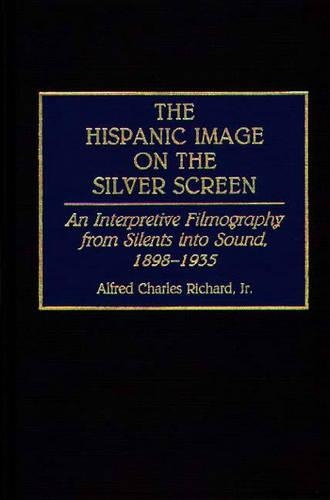
The Hispanic Image on the Silver Screen: An Interpretive Filmography from Silents into Sound, 1898-1935
(Hardback)
Publishing Details
The Hispanic Image on the Silver Screen: An Interpretive Filmography from Silents into Sound, 1898-1935
By (Author) Alfred Richard
Bloomsbury Publishing PLC
Greenwood Press
30th June 1992
United States
Classifications
Tertiary Education
Non Fiction
Reference works
791.43
Physical Properties
Hardback
624
Description
This is a collection of more than 1800 films dealing with Hispanic topics, themes, and characters arranged chronologically from 1898 to 1935, with in-depth annotations, cross-references and four separate indexes. It is a study of Hollywood's treatment of Hispanics worldwide, those living in South, Central and North America, the Philippines and Spain. Employing a historical framework, the author has organized the work for those interested in assessing the effects that motion pictures have had on the viewing public in establishing and perpetuating accepted stereotypes. The role of censorship, the Production Code Administration, the Motion Picture Society of the Americas, the Latin American market, and Hollywood's version of Hispanic history are fully covered. The Black Legend of Hispanic barbarity has existed in literature since the 16th century. The early film-makers, and later Hollywood, merely transferred the Black Legend to the silver screen and continued the accepted point of view created since the first conflict between England and Spain for supremacy in the Caribbean. This work also shows the relationship between film and foreign policy, how films have frequently justified and glorified North American intervention in the affairs of the Latin nations throughout the Americas. Each entry includes a brief scenario which details the film's Hispanic connection: a stereotype, a historic interpretation, a specific nation, associated behaviour or attitudes, a list of the Hispanic actors and actresses. Reviews, bibliography citations and archival locations are provided.
Reviews
A survey of 1,814 films dealing with Hispanic topics, themes, and characters, arranged chronologically from 1898 to 1935. Almost all of the entries include a brief scenario which details the film's Hispanic connection (those of special significance are described in some detail), followed by additional research material. Unless otherwise noted, the films were produced in Hollywood, and thus present Hollywood's treatment of Hispanics worldwide (i.e. South, Central, and North America, the Philippines, and Spain. Two further volumes are projected.-Reference & Research Book News
It is a valuable tool for researchers in many areas in that it is extensively cross-referenced through four indexes: title, performers, locations, and an excellent subject index that ranges from banana republic and Latin lover to Zorro.-Revista Interamericana De Bibliografia
Richard has compiled a first-rate reference work, the first of a projected multivolume filmography. It will be of great interest to those interested in the topic. This is a highly readable and important book that should be a welcome addition to all academic and large public libraries.-ARBA
This is a highly readable and important book that should be a welcome addition to all academic and large public libraries.-ARBA
"It is a valuable tool for researchers in many areas in that it is extensively cross-referenced through four indexes: title, performers, locations, and an excellent subject index that ranges from banana republic and Latin lover to Zorro."-Revista Interamericana De Bibliografia
"Richard has compiled a first-rate reference work, the first of a projected multivolume filmography. It will be of great interest to those interested in the topic. This is a highly readable and important book that should be a welcome addition to all academic and large public libraries."-ARBA
"This is a highly readable and important book that should be a welcome addition to all academic and large public libraries."-ARBA
"A survey of 1,814 films dealing with Hispanic topics, themes, and characters, arranged chronologically from 1898 to 1935. Almost all of the entries include a brief scenario which details the film's Hispanic connection (those of special significance are described in some detail), followed by additional research material. Unless otherwise noted, the films were produced in Hollywood, and thus present Hollywood's treatment of Hispanics worldwide (i.e. South, Central, and North America, the Philippines, and Spain. Two further volumes are projected."-Reference & Research Book News
Author Bio
ALFRED CHARLES RICHARD, JR. is Professor of Latin American History at Central Connecticut State University. He is the author of The Panama Canal in American National Consciousness (1990) and Postum, Post-Toasties, and Patriotism in Advertising and Popular Culture (1992).
